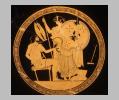
KEY TERMS
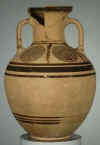

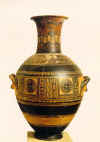

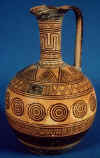

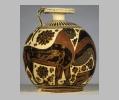
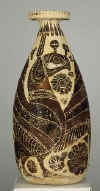
BLACK-FIGURE
TECHNIQUE AND
RED-FIGURE TECHNIQUE:
Black-figure technique was likely developed
around 700 B.C. in Corinth, and it may have been inspired by carved
ivories and engraved metals imported from the Near East. As the
name implies, figures appeared, after the firing of the pot, as black
silhouettes against the
background of the light red or yellowish clay of the pot. Within
the black figures, incised lines revealed the red clay beneath,
allowing the artist to trace the inner details of the figure.
Other colors - purple, white and yellow - were sometimes added for
highlighting. This technique was adopted in other Greek cities,
and, by the sixth century B.C., the Athenians surpassed the Corinthians
in the production of black-figure pottery. Athenian ware was
characterized by its shiny gloss and the brighter orange color of the
clay. In the decoration of the pots, Athenian painters placed
greater emphasis on human figures and narrative scenes.

TYPES OF GREEK POTTERY: SHAPES AND USES
For
an excellent survey of the different shapes of Greek pottery,
check out
this frame from the Beazley archive :
The images of the different shapes link to additional illustrations and
more complete explanations. The following are some of the most
important types:
amphora:
a tall, storage jar for oil, wine, olives, dry goods or
grain
hydria
: large, three-handled jar for carrying water: one handle
was used for pouring, two handles for lifting
krater : a large bowl for the mixing of wine and water at the
symposium or banquet
kylix: a shallow, circular, two-handled drinking cup - resembling a
plate - on a narrow stem
oinochoe:
a small pitcher used for pouring wine into the cups
EXAMPLES OF GREEK POTTERY PAINTING
-Dipylon amphora (Athens), grave-marker for a woman,
geometric style, mid-8th century B.C.; Dipylon
krater (Athens),
grave-marker for a man, geometric style, mid-8th century B.C.
-Chigi vase, Protocorinthian oinochoe, c. 640 B.C.,
hoplite warriors, POLYCHROME (many-colored) decoration, possible
influence of wall-painting
-fragment of a krater from Argos, mid-7th century B.C., blinding
of the CYCLOPS by Odysseus and his men (image
no. 1) :
-Protoattic amphora from Eleusis, grave-marker, mid 7th century B.C., blinding
of the Cyclops (image no. 2)

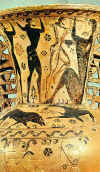
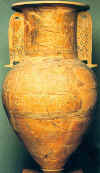
1.
Argos krater 2. Eleusis
amphora 3. Trojan
horse
-amphora from Mykonos decorated in relief, mid-7th century B.C., the
Trojan horse (image no. 3)
-Orientalizing pottery, examples from Rhodes and Corinth,
late 7th century B.C., stags, sphinxes and other animals:
-Francois vase, Attic black-figure krater by Ergotinos (potter) and
Kleitias (painter), c. 570 B.C., mythological scenes include stories of
Theseus, the Calydonian boar-hunt (the story told by Phoinix in book 9
of the Iliad) and the wedding of Peleus and Thetis, the parents of
Achilleus.
-Attic black-figure pottery: examples by the painter, EXEKIAS, include
the dice-game of Aias and Achilleus,
Aias carrying Achilleus' corpse (image no. 1) from the battlefield,
and DIONYSUS on the boat, c. 530 B.C.
-Attic red-figure krater painted by EUPHRONIOS, c. 515 B.C., death
of
Sarpedon
-Attic red-figure amphora painted by EUTHYMIDES, signed "As never
Euphronios", c. 510 B.C., drunken revellers (FOR A DRAWING OF THIS
SCENE:
CLICK HERE )
-Attic red-figure hydria by the Kleophrades painter,
c. 490 B.C., sack of Troy
-Attic red-figure krater by the Pan painter, c. 470 B.C.,
Artemis slaying Actaeon (image no. 2)
-Attic red-figure krater by the Niobid painter, c. 440 B.C.,
Herakles (image no. 3) in the underworld, the slaughter of
Niobe's children (image no. 4)
-Attic pottery of the fifth century on white
ground with polychrome decoration
1.
Aias and Achilleus 2.
Artemis and Actaeon 3.
Herakles
4.
Niobe's children slain
OTHER TERMS: conceptual representation ( EXAMPLE ), simultaneous narration ( EXAMPLE )
COPYRIGHT NOTICE: SMALL, LOW-RESOLUTION
THUMBNAILS HAVE
BEEN USED ON THIS PAGE SIMPLY TO FACILITATE LINKS TO COPYRIGHTED IMAGES
PUBLISHED
ON THE WEBSITES OF THE PERSEUS PROJECT (TUFTS UNIVERSITY) AND THE GREEK
MINISTRY
OF CULTURE. IF THE COPYRIGHT HOLDERS BELIEVE THIS TO INFRINGE
THEIR
COPYRIGHT, THEY WILL BE REMOVED.
******************************************************************************
FOOD FOR THOUGHT? Early forms of writing in the ancient Near East
(cuneiform and Egyptian hieroglyphics) were based upon pictures.
Do we still use "picture-writing"? Think about the use of pictures as a
form of short-hand writing in advertising and public signs, on the
internet, or in text messages. Discuss and compare two or three
examples of pictographs or visual
symbols in today's world. How do they get and convey their
meaning? Do they form part of larger systems of symbols or
"picture languages"?
******************************************************************************
******************************************************************************
FOOD FOR THOUGHT
Homer describes the scenes on the shield of Achilleus in great detail,
and his verbal description provides many details that might not be
easily represented or understood in a picture. He
reminds us that he is describing an object by mentioning the metals of
the shield, but he rarely refers to the location of the scenes on the
shield. Can you make a diagram of the layout of the scenes on
Achilleus' shield? How would your arrangement help a viewer to
understand and interpret the scenes on the shield?
******************************************************************************